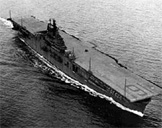|
Fred Gwynn's Chapter 1 |
|||||
 |
|||||
 |
|||||
| Norm Steerie, the Exec, had been through the nightmare of the Navy's desperate counter-attacks in the first months after Pearl Harbor. He had helped sink a Jap carrier and had had his own sunk under him. He had miraculously escaped death when he made a dry torpedo run on an enemy cruiser simply to divert anti-aircraft fire from another plane making a business run, and he had seen a lot of his colleagues killed. A normally retiring man, he had to be executive and omniscient in his new job. With all this weighing on his shoulders, he rarely smiled during office hours, and while one could not blame him, one felt that the morale of the organization, was impaired by his aloofness. The management of flight operations, naturally the most important liaison job, had fallen to John Bowen, whose lack of administrative tact vitiated his really thorough knowledge of flight operations. He had taken a lot of guff as an ensign and seemed determined that we should be exposed to the same syllabus. Where knowledge and light from Isely and Steerie, should have filtered through him to us, a dark veil was permanently in overwhelming evidence. Flight operations themselves were in a muddle, partially for legitimate reasons. We had a flock of turret gunners actually greener than we were, some of them having just come out of boot camp across the Bay at Newport. We had to spend hours and hours of towing a target sleeve or flying them by the sleeve while they shot at it. It was necessary but tiring training, and we felt that the least a squadron about to go into combat could expect were some crewmen who had been through primary gunnery training. Most of the pilots had just come from the new torpedo school at Ft. Lauderdale, Florida, where pilots recently returned from Pacific action gave an excellent course in tactics. When we got to Quonset we found that the torpedo attack doctrine was based on a physically impossible problem in relative motion, too complicated to explain here without diagrams. For some reason, this doctrine persisted all through the spring until we were on the shake-down cruise, when a memorable and somewhat mutinous session in the ready-room restored maneuverability to our attack plans. Let it be said however, that once our leaders accepted the Lauderdale technique, they improved on it and made it the most effective and workable torpedo-bombing attack one could imagine. It is wearisome and a little vindictive to recount all these self-pitying tribulations, but they were very real at the time and remain so in the memory. They were numerous, and they added up to dreariness and confusion. Yet on the other side of the ledger were three attractive aspects of Quonset. There is a magnificent Officer's Club on the station, spacious and comfortable, and serving good food and drinks. Pilots can be happy for a few hours each day on any station that has plenty of liquor available. Secondly, Providence is a pretty good liberty town, and Boston (fifty miles from Providence) is even better. We got one day off in eight, and even if we had to sneak out of the hangar early and skip the ferocious volley-ball game that the Skipper served up daily, we could get to town for twenty-four hours of life as she should be lived. I remember looking forward to those days off as a kid waits for Christmas. In the third place, the flying area off Narragansett Bay is a dream, if you happen to like New England. Down the widening Bay, over the Jamestown Bridge (where they stretched cables to keep planes from flying under it), to the southern shore of Rhode Island and Connecticut is a beautiful trip. You soon hit the northeastern parts of Long Island going that way, and going east you have three lovely Atlantic islands - Block Island, Martha's Vineyard, and Nantucket, and the interesting archipelago off Falmouth. Continuing northeast you run into Cape Cod, and coming back to Quonset you pass over the plush relic of Newport. Having spent some summers on Nantucket in the past, I relished the treat of flying a military plane over the windy beach of Tom Nevers Head, the bluffs at 'Sconset, and across the moors and cranberry bogs up the Wauwinet spit and back over ancient Nantucket Bay and Town. Below there, two years before, I had lain on the beach, face down beneath the sun, and talked to Walter Ellis about being drafted. End of Page 4 of Chapter 1 — Go to Page 5 Page — 1 — 2 — 3 — 4 — 5 — this chapter you may go to Introduction — Table of Contents Chapter — 1 — 2 — 3 — 4 — Epilogue — or Go to the Lexington Stories Cover Page Or Home - Contact Us - Cold War Hist. - 91st SRS Hist. - Stardust 40 Mission Story |
|||||